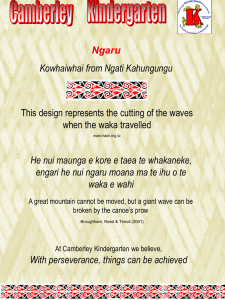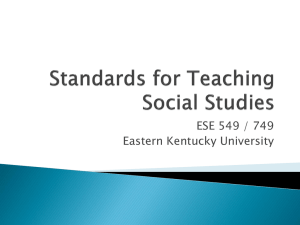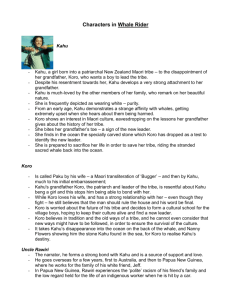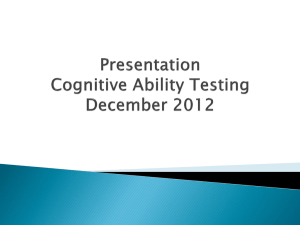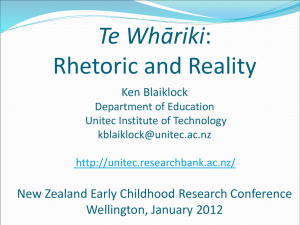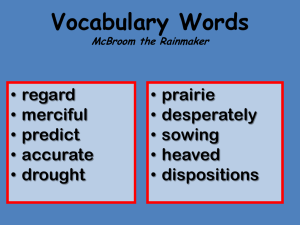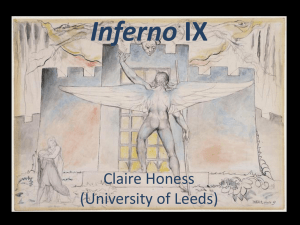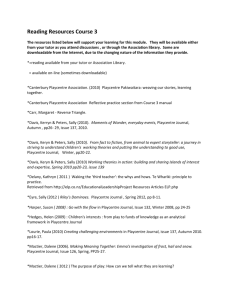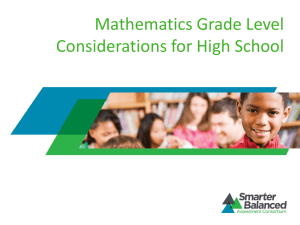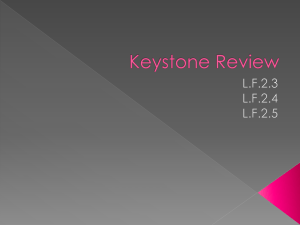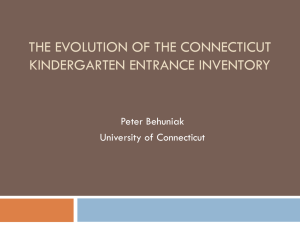Learning Notes - Research Bank
advertisement
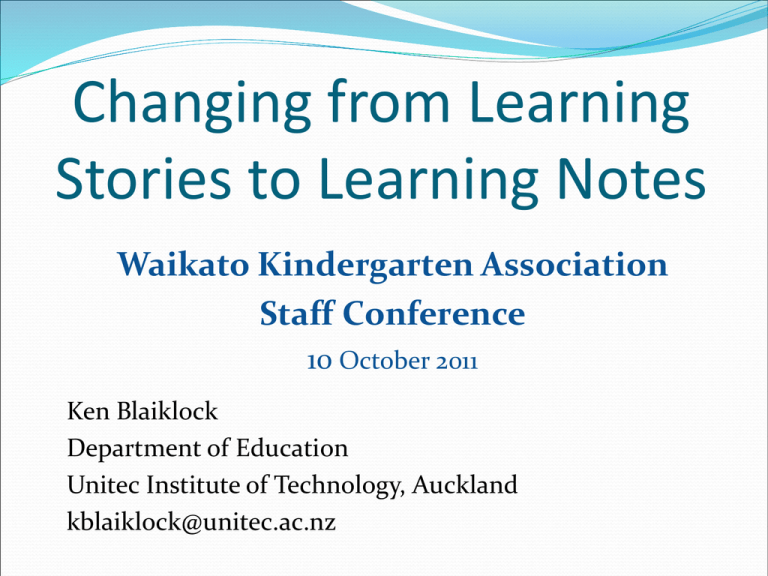
Changing from Learning Stories to Learning Notes Waikato Kindergarten Association Staff Conference 10 October 2011 Ken Blaiklock Department of Education Unitec Institute of Technology, Auckland kblaiklock@unitec.ac.nz Blaiklock, K. (2010). Assessment in New Zealand early childhood settings: A proposal to change from Learning Stories to Learning Notes. Early Education, 48, 5-10. - article can be downloaded from the Unitec Research Bank http://unitec.researchbank.ac.nz/handle/10652/1601 Learning Stories Learning Stories are used extensively in NZ centres. Said to be for all ages and all experiences. Often they are the only form of “assessment”. Widely praised. Promoted with millions of dollars of funding for Kei Tua o te Pae and professional development courses. Supported by ERO. See Carr (1998, 2001). See Ministry of Education (2004,2007,2009) -Kei Tua o te Pae books. Ministry of Education (2004). Kei Tua o te Pae, Book 4, p.19). 4 Ministry of Education (2009). Kei Tua o te Pae, Book 20, p.22 Why change from Learning Stories? Learning Stories have some benefits: A record of children’s involvement in some activities. A way to foster centre-home links and promote communication between teachers, children, and families (Ramsay et al. 2007). A way to promote interest in literacy (Hatherly, 2006). However, there is little empirical evidence that Learning Stories are an effective and practical assessment technique. Significant problems in using Learning Stories to assess children’s learning. (see Blaiklock, 2008, NZRECEJ) Problems with Learning Stories 1. Publications on Learning Stories provide little guidance on where, when, and how often to make Learning Stories. 2.Variable information given in professional development courses on Kei Tua o te Pae. 3. Time consuming to produce, meaning they are often made only once a month for each child. Not representative of a child’s learning. 4.Problems with including subjective interpretations at the time of recording observations. Lack of attention to accuracy. 5. Difficulties with establishing the validity or credibility of Learning Stories – It may be a story but is it an assessment? 6. Problems with defining the learning dispositions that are supposed to be the focus of Learning Stories. Dispositions are important but they are not effectively assessed with Learning Stories 7. Problems with the links between behaviours, dispositions and the strands of Te Whāriki Strand Disposition Behaviour Belonging Courage & Curiosity Taking an interest Well-being Trust & Playfulness Being involved Exploration Perseverance Persisting Communication Confidence Expressing an idea or feeling Contribution Responsibility Taking responsibility 9 8. Concern that a focus on dispositions can lead to the neglect of knowledge and skills. 9. Problems in using a Learning Story about a specific experience as a basis for planning future learning experiences in different contexts. 10. Problems in using Learning Stories to show changes in children’s learning and development over time (-lack of attention to this in Kei Tua o te Pae). Licensing Criteria for Early Childhood Education and Care Centres (2008) Services should be “informed by assessment, planning and evaluation (documented and undocumented) that demonstrates an understanding of children’s learning, their interests, whanau, and life contexts” (Ministry of Education, 2009, p.8). The type of assessment is not prescribed. No requirement to use Learning Stories. The lack of research evidence, and the numerous problems identified with using Learning Stories, suggest it is timely for centres to consider a different approach. Learning Notes Learning Notes consist of 3 parts. (1) Describe (2) Interpret (3) What Next? Learning Notes (1) Describe – description of child’s involvement in a particular learning experience. May be short (a sentence or two)or long (several paragraphs). -recorded as accurately as possible as soon as possible after event. Observations can be recorded in notebook or on ‘post-it’ notes for later transfer. If abbreviated details recorded, these can be written up more fully later in the day. - may be accompanied by a photo or example of child’s work. The “Describe” section may be all that is required. (in which case the subtitle “Describe” is not needed) Learning Notes If appropriate, can also include an: (2) Interpret section – comment that highlights the significance of the learning. - could be linked with principles , strands, goals, and indicative learning outcomes of Te Whāriki (-this could help to show that a range of learning areas are being assessed). “Interpret” contd. Potential problem with Te Whāriki is that important domains of learning (e.g., physical development, language development) can be overlooked. Assessments may be made for all of the strands of Te Whāriki but crucial areas may not be covered. Well-being; Belonging; Contribution; Communication; Exploration “Interpret” contd. Children learn holistically but it can be useful to be aware of domains of learning. “Curriculum Subject Areas” also important (e.g., art, music, mathematics, literacy …). Hence, other publications on children’s learning can be useful for the “Interpret” section of a Learning Note. Early Years Foundation Stage (UK)- Three “prime” areas: 1. Personal, social, and emotional development 2. Communication and language 3. Physical development Learning Notes (1) Describe (2) Interpret In some cases will also include a: (3) What Next? section – when it is useful to record ideas for related future experiences – to be enacted as soon as possible. Examples of Learning Notes Some examples of “Describe” (No need to write a whole “story”. No need to focus on “dispositions”.) Sarah climbed up and went down the slide independently for the first time this morning. Huan counted to 12 this afternoon when arranging the pieces of the wooden car puzzle. Eloni and Ezra talked frequently with each other as they role-played cooking in the family area for about 15 minutes. They asked me to try their pizza and both told me they were friends. A Learning Note Kayla. Weds, 17 Aug, 1.00pm Describe After lunch, Kayla spent about 20 minutes riding up and down the sloping path on the trike. She called out, “I’m very fast.” Interpret Kayla has become more confident in using the trike since she developed the motor skills needed to use the pedals (- a skill typically found for three year olds – see Allen & Marotz, 2007, Developmental Profiles). Links with Te Whāriki, Exploration, Goal 2, Children experience an environment where they gain confidence in and control of their bodies. Example of a Learning Note Kahu. Age 4 years, 7 months. Tues, 16th August, 11.30 am, Writing Table Describe Kahu sat at the art/writing table for about ten minutes. He worked independently, trying out different pens and colours. He nearly always used his left hand, often using a “fist grip” to hold the pens. He then presented his work to me and said “This is a letter for you. Read it.” Interpret Kahu appears to be showing a preference to use his left hand when writing/drawing and is trying out ways to hold a pen. His “letter” showed a mixture of lines at different angles, and repeated patterns. He had repeatedly written “K,” the first letter of his name. He displays an understanding that writing involves repeated symbols and letters, and that it can be “read” by other people. -Links with Te Whāriki , Communication Goal 3, Learning Outcome -an understanding that symbols can be read by others…. -Fits with the “Inventing Writing” phase described on page 14 of Clay’s (2010) book, - How Very Young Children Explore Writing. What next? Tomorrow I will give Kahu an envelope with his name written on it, containing a letter from me to Kahu that thanks him for his letter. I will show Kahu some blank envelopes and paper and ask if he would like to write some more “letters”. This will provide me with opportunities to talk about what he would like to write and to provide guidance with writing the letters in his name and using the correct pencil grip. I will encourage him to use the triangular shaped pencils to assist with this. Learning Notes are useful for both formative and summative assessment Formative – ongoing “assessment for learning”. The flexibility and ease of recording Learning Notes means that they can be made more frequently and should be of more value for planning future learning experiences than are Learning Stories. Summative – to “sum up” a child’s performance in a particular area of learning and development. For example, a learning outcome in Te Whāriki , or an area within another framework of early learning (e.g., EYFS). Will require collecting a range of Notes on same area. Learning Notes can be spontaneous or planned Spontaneous observations can be made when teachers recognise significant moments in children’s learning. [Recognising these moments is enhanced when teachers are knowledgeable about typical developmental progressions. ] Planned observations may focus on particular areas of learning and development. May be used to ensure a range of observations of different areas and domains of learning are made. Learning Notes can be collected in a Child’s Portfolio Filed in children’s portfolios, along with photos of events and examples of children’s work. A copy of a Learning Note can be sent home the day it is made - so parent and child can discuss event while it is still significant. The “Describe” section of a Learning Note can be written with a child. Ideal way to enhance understanding of early literacy. Learning Notes Describe Interpret What Next?
